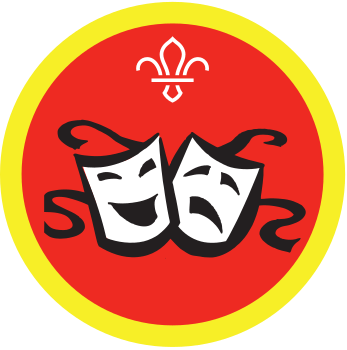
Learn and perform some mini magic tricks
You’ll need
- A small box of crayons
- Pencils
- Sugar cubes
- A glass of water
Before you begin
- Use the safety checklist to help you plan and risk assess your activity. Additional help to carry out your risk assessment, including examples can be found here. Don’t forget to make sure all young people and adults involved in the activity know how to take part safely.
- Make sure you’ll have enough adult helpers. You may need some parents and carers to help if you’re short on helpers.
Time for magic
- Gather everyone in a circle. Tell everyone that they’ll practising and performing some magic tricks.
- Ask if anyone has tried magic tricks before or if anyone knows any tricks.
- Ask if anyone knows any magicians. People may say Stephen Mulhern, Issy Simpson, Houdini, Dynamo, Penn and Teller, Derren Brown, Magic Bones or Ben Hart.
- Ask if anyone knows what the magic circle is. Tell everyone the magic circle is a British organisation that’s dedicated to promoting and advancing the art of magic. To be able to join it, people must qualify for membership. To qualify, you can either take a performance exam or write an essay on a branch of magic. If successful, they’re designated Members of The Magic Circle.
- Divide everyone into four groups and allocate each team a trick.
- At the end ask each team to ‘perform’ their trick for the rest of the group. They should also show how it’s done, but everyone watching could share ideas or take a guess at how it’s done first.
Share some top tips for performing magic
- Involve the audience: The secret to being a good magician is to a lot of audience participation. Whether it’s talking to people, getting them clapping along or shouting out, or using people in your act, you’ll get everyone interested in the magic trick. If you can interest the audience in what you’re talking about too as you move objects or your hands around, they won't be able to see that little sleight of hand that’s going on when their eyes are distracted.
- Learn your craft: There are many kinds of tricks, so find the one that works for you. Some are sleight of hand, some are restoring objects after they’ve been broken or ripped, some are making things appear and disappear, and some are card tricks. Try to learn lots of different kinds of tricks, so you can have a really varied act. Lots of magicians rely on technology, gadgets and little devices to help them with their tricks, too. You could see if you could learn any digital magic tricks.
- Practice and practice: Practising really grows your confidence, as well as your ability to perform the tricks well. If you want to be a great magician, you’ll need to spend a lot of time practising even simple tricks to be sure they get them right without having to think about it.
- It’s okay if it takes time: You can’t become a magician overnight but getting your brain to work with your hands and body to fool the audience will take time. Many beginner magicians might be able to learn a few simple tricks within several hours of practice, but more complex tricks will take much longer to learn.
- Keep it simple: You might not have the equipment to do many of the tricks you see on TV or online, so you might want to keep the tricks you learn simple. The simple tricks are often easy to learn and inexpensive, so can be great for beginners to learn magic, build confidence in performing and be successful at.
This trick gives the impression that you can read minds and are able to guess what colour crayon someone chooses without looking.
- Choose someone to be a volunteer for your trick.
- Give them several coloured crayons to choose from.
- Now, turn around and stand with your back facing the volunteer. Place your hands behind your back.
- Keeping your hands behind your back, so you can’t see them, ask the person to pick a crayon and place it in your hands.
- Hold the crayon in your fingers and turn back around to face the audience. Your hands and the crayon should remain behind you.
- Talk to the audience about something. It could be about magic, what they’re favourite colours are or your ability to read minds. As you are talking and the audience is distracted, scrape the crayon with your right thumbnail to transfer some wax.
- Keeping the crayon behind your back in the left hand, distract your audience with your right hand by making magical hand gestures. You could say something, such as ‘I’m reading your mind, the chosen colour will be revealed’.
- Wave your hand in front of your eyes and, as you do, take a quick glimpse of the colour of the wax that’s on your thumbnail. That’s the colour of the crayon.
- Now build up the tension and reveal the answer to your audience.
This trick helps you to transfer a pencil drawing from a sugar cube to someone’s hand, even after the sugar cube disappears.
- Have someone from the audience pick a letter.
- Write that letter on a sugar cube using a pencil.
- Pick up the sugar cube. Make sure the side that’s been written on is against your thumb and squeeze the sugar cube. The letter will be transferred from the sugar cube onto your thumb.
- Now, ask the person to drop the sugar cube in a cup of water and watch it melt.
- Ask for your volunteer’s hand and press your thumb against their palm. The letter will transfer to the person’s palm.
- For a magical effect, ask him/her to wave their hand over the glass of water and see the letter appear on their hands!
This trick is an optical illusion, seemingly transfer a hard object into something a lot more flexible - watch as a pencil bounces and bends!
- Hold a pencil closely to the very end of the eraser side. Make sure you’re gripping it loosely between your thumb and index finger.
- Shake your hand up and down, letting the pencil flop up and down as well. When you get the right speed, it’ll fool people into seeing the pencil bending and waving. I's just an optical illusion, but a very fancy one.
- It doesn't take very fast movements, but practice getting the speed just right to make the pencil appear to bend as you bounce it with a loose grip.
This trick’s an optical illusion which gives the impression that the pencil is magically connected to the hand.
- Hold a pencil in one hand while grabbing your wrist with the other hand.
- Open the hand holding the pencil, while secretly using the index finger on the other hand to hold the pencil against your palm. This gives the impression the pencil has become magnetic.
- When you’re ready, move your hand up and down to wow the audience.
Reflection
Magic tricks are a fun way to wow your friends and impress your loved ones. If you keep practising magic tricks, you’ll often remember them for a long time and get good at them. You never know when they might come in useful, too. You could use your magical skills to perform at a school event. It could become a party trick that you perfect, or magic could even become a career if you really enjoy it.
How did you find doing these tricks? Are there any tricks that you didn’t do that you’d like to learn?
There are lots of places where you can learn different magic tricks, such as through online videos, but a big part of doing magic is performance.
How did it feel to perform? Did you feel confident? Did anything go wrong and how did you fix it? Did you remember everything and remember to smile, too?
Most importantly, did you have fun? What top tips would you give others trying to perform magic?
Safety
All activities must be safely managed. You must complete a thorough risk assessment and take appropriate steps to reduce risk. Use the safety checklist to help you plan and risk assess your activity. Always get approval for the activity, and have suitable supervision and an InTouch process.
You could change the magic tricks you learn to make this activity harder or easier.
Make sure to think about which young person would suit which trick.
If anyone needs help or struggles with fine motor skills, give them the opportunity to work in pairs, with a young leader or an adult volunteer. Alternatively, swap out the items for something easier to handle.
If people may struggle with the tricks, is there another way they could join in? Could they be a volunteer or introduce each group to the stage? You could also put on a magic show, so people could play the music or making decorations.
Anyone who struggles with reading can join a group with a more confident reader who’s happy to read the tricks out loud.
If a player has difficulties communicating verbally you could explore doing this activity without speaking – can you use music to add tension to a performance?
People can work in small groups or as a whole group, depending on what will work best for your group. If needed, let people be in bigger groups to make sure everyone’s supported in taking part in the activity. A young leader could join a group to help people to take part, too.
All Scout activities should be inclusive and accessible.
You could keep practising these tricks and put on a small magic show for parents, carers and other Scouts. Alternatively, you could try some harder tricks or see a magician perform live, either being invited to your meeting place or at a local event.
If anyone knows any other magic tricks, they could put on a performance, teach other people or show off their trick.

